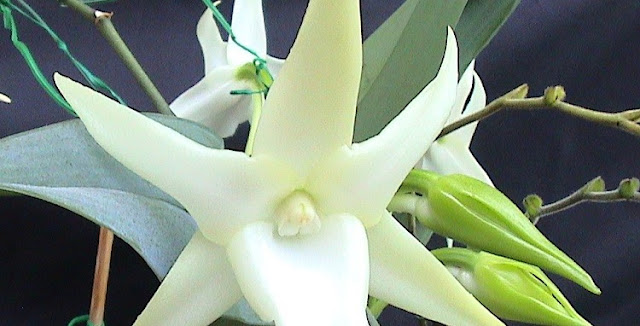 |
| Christmas Star Orchid - Angraecum sesquipedale |
 |
| Angraecum sesquipedale and pollinator moth |
‘...I have just received ..... the astounding Angraecum sesquipedale with a nectary a foot long. Good Heavens what insect can suck it?...’
Later that year, Darwin predicted that the long flower spur must have co-evolved with a pollinator moth with an equally long proboscis, a theory which drew particular ridicule from this critics. However, it was not until after his death in 1903, and 41 years after writing his original letter to Hooker, that the pollinator (the Malagasy subspecies of the African hawk moth) was discovered by Lionel Walter Rothschild and Karl Jordan and Darwin's theory was finally vindicated. The hawk moth was named Xanthopan morganii praedicta in honour of Darwin’s original prediction. Since then it has also gained the common name of Darwin's orchid.
 |
| Angraecum sesquipedale botanical illustration |
In their native habitat the flowers will emerge from June to September, however when cultivated in Europe however, the flowers appear between December and January. They produce an intense spicy scent, but as this species is moth pollinated the fragrance is only present at night.
The leathery leaves are dark green with a grayish bloom and a bilobed tip. They measure approximately 22–30 cm long and 3 cm wide. Like the majority of epiphytic orchid species the roots are thick and silver-grey in colour.
For related articles click onto the following links:
CHRISTMAS STAR ORCHID - Angraecum sesquipedale
CHARLES DARWIN'S FAVOURITE ORCHID - Catasetum species
HOW TO GROW THE HYACINTH ORCHID
HOW TO GROW MONKEY FACE ORCHIDS FROM SEED
HOW TO GROW THE WHITE EGRET FLOWER - Pecteilis radiata
MONKEY FACE ORCHIDS
NAKED MAN ORCHID - Orchis Italica
SCHOMBURGKIA EXALTATA
THE ANGEL ORCHID
THE ANGEL ORCHID - Habenaria Grandifloriformis
THE FLYING DUCK ORCHID
THE MOTH ORCHID - Phalaenopsis species and cultivars
THE ORCHID CACTUS - Disocactus ackermannii
THE SWADDLED BABIES ORCHID - Anguloa Uniflora
THE VAMPIRE ORCHID - Catasetum macrocarpum
THE WHITE EGRET FLOWER - Pecteilis radiata







No comments:
Post a Comment